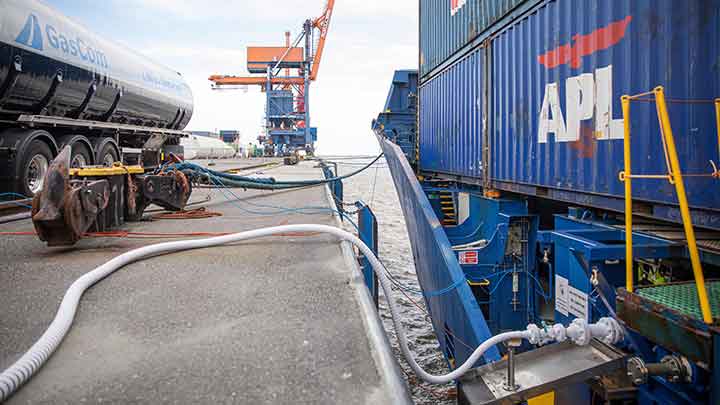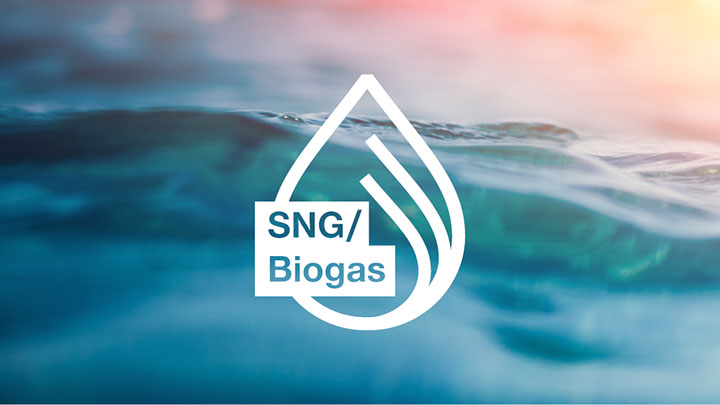SNG: Synthetic gas for the maritime transition

A viable path to decarbonization
MAN Energy Solutions is driving the maritime energy transition with technologies for low-carbon fuels, including green engines and retrofits. Our synthetic natural gas (SNG) solutions offer you a clear path to low-carbon shipping.

From HFO to LNG to SNG
Most of the world's ships run on heavy fuel oil (HFO). The climate crisis has made it essential to find low-carbon alternatives. In recent years, liquefied natural gas (LNG) has become the alternative of choice, but it still a fossil fuel that produces greenhouse gases (GHG). SNG is a new low-carbon alternative. SNG is chemically the same as the main combustible constituent of LNG, so it can used as a direct replacement or blended with LNG, depending on the supply.
SNG as maritime fuel
SNG is optimally suited for the two- and four-stroke dual-fuel engines in MAN’s range and ideal for ships that already run on LNG and aim to save additional emissions. Achieving fuel supply aboard ship is straightforward enough with the right equipment – as with LNG. The new gaseous fuel has to be held at cryogenic temperatures prior to bunkering (-162°C). However, an already established LNG infrastructure can also be used for fueling with SNG.
Reference case: ElbBLUE
World’s first use of SNG in commercial shipping
In September 2021, the 1,036-TEU vessel ElbBLUE, which had been retrofitted with a four-stroke MAN 51/60 dual-fuel engine in 2017, also became the first container ship worldwide to use climate-neutral SNG on a commercial trip. The ship replaced approximately 50% of its bunkered gas fuel with SNG from the Kiwi AG plant in Wertle, Germany. The test proved that any LNG-retrofitted ship can run on carbon-neutral fuels generated by Power-to-X technology.
Read moreManaging Methane Slip
Does the issue of methane slip affect the climate benefits of LNG as an engine fuel for marine applications? Download this paper and find out more about the various countermeasures the company has taken for this purpose.
Synthetic natural gas (SNG) can be derived from fossil fuels and biomass via gasification and methanation processes. SNG can also be produced by, for example, renewable or surplus energy in power-to-gas systems. Biogases are produced from biomass and waste products – and the resulting liquefied fuels can be referred to as BioLNG or LBG (liquefied biogas) and sometimes LBM (liquefied biomethane).
Main advantages:
- SNG and Biogas have the same low NOx, SOx and particulate matter emissions as LNG, but they can be CO2 neutral depending on the feedstock and conversion energy source
- Depending on the source fuel, SNG and Biogas can be a carbon-neutral substitute for fossil fuels
- SNG and Biogas can be blended with LNG to gradually reduce the CO2 footprint
- Considered to be excellent bridging fuels during the ongoing energy transition
Focus areas:
- The availability of SNG and Biogas as bunker fuel
- Increase of production capacities Read more

Solutions / technologies by MAN Energy Solutions:
Two-stroke:
|
|
| Four-stroke: |
|
| Cryogenic equipment |
|
Other future fuels
Related news
Shipbuilding Projects with Ammonia Engines Firm Up
Imabari Shipbuilding will install an MAN B&W 7S60ME-Ammonia engine with SCR in connection with the construction of a 200,000 dwt class bulk carrier for a joint venture between K Line, NS United and Itochu Corporation. The business represents one of the first projects for MAN Energy Solutions’ ammonia-powered engine that is currently under development in Denmark. MITSUI E&S will build the engine in Japan.
Brian Østergaard Sørensen, Vice President and Head of Research & Development, Two-Stroke at MAN Energy Solutions, said: “This project marks another important milestone in our ammonia-engine development and indeed for the maritime industry in general. It also confirms that we are on the right track in relation to our dual-fuel ammonia concept where we have gained a great understanding of ammonia’s unique characteristics as a marine fuel via our two-stroke engine testing, which we started in early June 2023. Equally as important, we are confident of how to handle it safely; it is very satisfying to see our hard work beginning to pay off.”
Bjarne Foldager – Country Manager, Denmark – MAN Energy Solutions, said: “The interest in this revolutionary engine had been overwhelming, even prior to our two-stroke ammonia-engine testing, but has even intensified after the important lessons learnt from ammonia-combustion testing on the test engine here in Copenhagen. While the current growth in shipping will increase greenhouse-gas emissions, alternative fuels like e-methanol, e-methane and green ammonia will eventually come to compete with fossil fuels but we need regulation to encourage their adoption in the industry. Regulatory clarity from the EU and IMO is improving but now we need the right market-based tools to be introduced in order to bring the industry towards carbon neutrality for 2050.”
Thomas S. Hansen, Head of Sales and Promotion, MAN Energy Solutions, said: “MAN Energy Solutions has developed this engine since 2019 with over 100,000 man-hours recorded in that time. This first MAN B&W ammonia engine is a 60-bore type, which is applicable to a broad range of vessel segments. We believe that the success of ammonia as a marine fuel strongly relies on a safe introduction to the market. We will therefore monitor a number of engines entering operation at sea to ensure that the engine design and functionality of the auxiliary systems meet our expectations before the engine is formally introduced to our marine-engine programme as part of a full sales release. In the short term, we expect a fast uptake of ammonia-fuelled engines towards the end of the decade as we obtain positive seagoing experience from the first engines. In the long term, we expect ammonia to comprise around 35% of fuel used onboard large merchant-marine vessels by 2050 due to lower production cost compared to other e-fuels relevant for large merchant-marine vessels.”
Documents
-
PR First Ammonia Engine_EN
Contact
Nils Søholt
Trade Press Marine
Group Communications & MarktingMAN Energy SolutionsTeglholmsgade 412450 Copenhagen SVDenmark
nils.soeholt@man-es.com t +45 33 85 26 69Available languages
- DE ·
- EN
